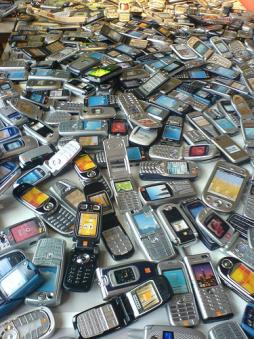e-waste
Posted by AnneryanHeatwole on Mar 03, 2010
The United Nations Environment Programme has released a new study on managing e-waste for developing countries. The report focuses one three major points: the market potential of e-waste recycling, encouraging the adoption of the UNEP’s guidelines to foster innovation in e-waste recycling technologies, and identifying places in which e-waste recycling is thriving.
The study acknowledges that data of e-waste is insufficient, but the United Nations University estimates “that current e-waste arising across the twenty-seven members of the European Usnion amount to around 8.3 – 9.1 million per year; global arising are estimated to be around 40 million tons per year.”
The report used data from 11 representative developing countries to estimate current and future e-waste generation - which includes old and dilapidated desk and laptop computers, printers, mobile phones, pagers, digital photo and music devices, refrigerators, toys and televisions.
Posted by AnneryanHeatwole on Feb 22, 2010
Recycling: From E-Waste to Resources data sheet 3236 Views
Author:
Mathias Schluep, Christian Hagelueken, Ruediger Kuehr, Federico Magalini, Claudia Maurer, Christina Meskers, Esther Mueller, Feng Wang
Abstract:
Sustainable Innovation, understood as the shift of sustainable technologies, products and services to the market, requires a market creation concept and one common global agenda. The challenge is to raise awareness among all actors of the different sectors in order to realize the innovation potential and to shift to eco-innovations that lead to sustainable consumption and production patterns.
Throughout this study prepared within the “Solving the E-Waste Problem (StEP) Initiative” the focus lies on a consistent set of different types of metals (ferrous and non-ferrous metals) such as aluminium (Al), copper (Cu), palladium (Pd) and gold (Au). Toxic and hazardous elements are present in e-waste, which are partially drivers for the implementation of sound collection and treatment processes. Therefore in the discussion of recycling technologies, the proper handling and treatment of such harmful elements to prevent environmental or health impact is included. Furthermore, the use and generation of toxic/hazardous substances during e-waste processing (for example, a mercury-gold amalgam or combined dioxins from inappropriate incineration) is critically evaluated with respect to the sustainability criteria for innovative technologies.
The study, structured in three parts, has the following three main objectives:
(1) Analysis of the market potential of relevant technologies for the e-waste recycling sector in selected developing countries,
(2) Examination of the application of the ‘Framework for UNEP Technology Transfer Activities in Support of Global Climate Change Objectives’ in order to foster the transfer of innovative technologies in the e-waste recycling sector,
(3) Identification of innovation hubs and centres of excellence in emerging economies relevant for e-waste recycling technologies.
Posted by CorinneRamey on Apr 22, 2008
In the United States, a used mobile phone is likely to end up in the trash can, or more likely, in the back of a desk drawer for several years, collecting dust. But in the rest of the world, this just isn't the case. Mobile phones -- or even parts of mobile phones -- are reused, recycled, and refurbished.
Jan Chipchase, a phone anthropologist for Nokia, has seen the way that old mobile phones transform into new ones while traveling for Nokia around the world. According to this CNET News article, Chipchase and his team (MobileActive wrote about Younghee Jung, an anthropologist who works with Chipchase, here) have found that refurbishing phones is a booming market in developing countries, with small businesses springing up that sell phone parts, repair manuals, and pirated versions of the newest software.


